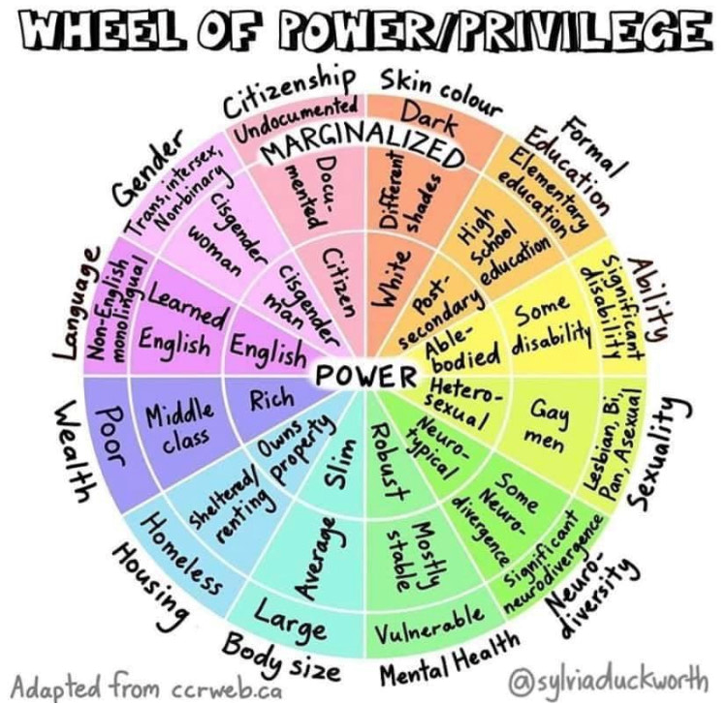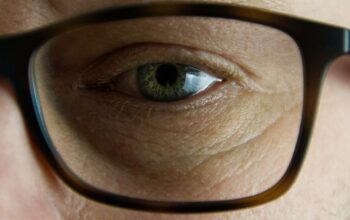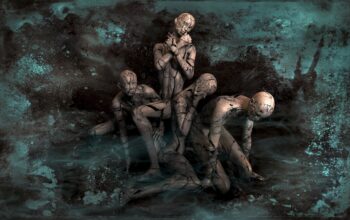Discrimination is not an isolated phenomenon, but several types of discrimination can happen at the same time, intertwining with each other and creating unique realities for different people. The introduction of Intersectionality was ground-breaking in its approach to understanding social problems, as it finally gave us the means to look at discrimination in all its facets. Adopting an intersectional approach is important in every aspect of life, from our work life to our interactions with people. But how can we manage to achieve a more intersectional approach? the first step is to understand where we stand, where we are on the privilege scale, why we are in that position, and for what reasons others might be in a more or less privileged position. If we cannot immediately visualize our position, there is an incredibly useful tool to understand where we stand, called the Wheel of Power & Privilege.

The Wheel of Power & Privilege is a creative sketch drawn by Canadian teacher and author Sylvia Duckworth that simplifies power and privilege dynamics in our societies. This wheel can help us visualise all the identities and power structures that intersect within us. This clever drawing can teach us where we stand and where other people with different identities intersections stand. The wheel shows which characteristics are more likely to put people in a position of power and privilege in our societies, and which characteristics are more likely to put people in disadvantaged positions. People in those positions not only do suffer from daily discriminations from other people, they also often lack rights and are often forgotten by governments, for example people part of the LGBTQ+ community, or immigrants, or people with disabilities, or people at the intersection of those different identities. For people in the outer circle, it is often hard to make a change and even harder to let their voices be heard. For this reason, it is crucial to “Respect the voice of those most affected by issues by centering their voices, respecting their goals for their communities, and stepping aside and allowing them to serve as spokespeople for their own causes”. With this in mind, one way to have a more intersectional approach may be simply listening to people’s stories.
From my personal experience, stories made an actual change in my approach to reality and social problems. My first encounter with Intersectionality happened through the book Bad Feminist, a collection of essays by the American writer and professor Roxane Gay. The topics range from her personal life to opinions about popular culture, music, films, and tv shows, to thoughts about social and political issues, such as race and gender. In the essays about her personal life, she talks about the different challenges that she faced growing up as a black woman, as a daughter of immigrants from Haiti, but she also talks about her sexual orientation, her relationship with her body shape, and the impact that they had on her personal and professional life. Those essays made me realise for the first time that some people face different life challenges due to a combination of factors that they can’t control and the least I could do was to listen and try to understand them. Another perfect example of stories that can help us open our eyes to intersectionality is the book Girl, Woman, Other by the British-Nigerian writer Bernardine Evaristo, co-winner of the Booker Prize 2019, together with Margaret Atwood’s The Testaments. The novel “is intersectional in its activism, showing gender, sexuality and class to be inextricably tied to studies of race”. It tells, in fact, the stories of twelve distinct characters, mostly black and mostly women, of different, origin, class, upbringing, age group, sexual orientation, gender identity, family situations. It proves brilliantly how the overlapping of each different identity creates different situations of privilege and discrimination and it gives an incredibly realistic point of view of each character and how their different life experiences make up today’s social fabric.
These are just two small examples of stories that can open our minds. Fortunately, every day we gain a greater access to stories told by those “marginalised” categories. The publishing industry, just as the film and TV industry are slowly finding more space for the representation of many marginalised categories, giving us the chance to broaden our horizons and overturn our prejudice. Learning about people’s experience and struggles through their stories will allow us to interact with them consciously. And once we learn about people’s different realities, the next step toward an intersectional approach is striving for inclusion.
“When speaking about issues, it is critical to recognize that there are multiple voices within a movement; that there is no singular way of experiencing an issue; and that various voices and perspectives need to be considered in order to make real, lasting, and equitable change”.
In any context, we must keep in mind that there are different points of view, and we must make sure that those points of view are part of the conversation. Inclusion means making sure that those people in the middle and outer circle of the Wheel of Power & Privilege have the same opportunities as those in the inner circle. But it also means considering that those people might have different needs that we must meet in order to create a safe environment for them.
In short, having an intersectional approach in our daily life is not impossible, or even difficult. All it takes is an open mind, a little empathy, and the will to put an effort into making a real change. And the more people adopt an intersectional approach in their daily life, the more it will be easier to reach those bigger power structures.
Francesca Cuomo



